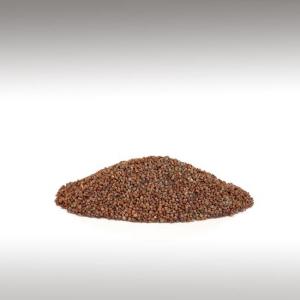
PERILLA SEED OIL (PERILLA FRUTESCENS) - BASE OILS

BASE / GENERAL DATA
Information submited: June 21, 2015 Modified: May 9, 2018 By: OperaDreamhouse
Perilla is an herb of the mint family, Lamiaceae. Though known to several cultures by different names, the disparate varieties are now classified under the single species Perilla Frutescens.
Perilla Frutescens the aromatic leafy herb called by its Korean name Jasoyup, its Japanese name Shiso, which in turn is a loan word from Chinese: Pinyin, Zĭsū, Wade - Giles: Tsu-su.
The plant occurs in red (purple - leaved) or green - leaved forms. It also has a less fashionable translated name "Beefsteak Plant", but starting around the 1980, with the rise of popularity of Japanese cuisine, it has become increasingly more chic for the mass media to refer to it as Shiso.
Suggested native origins are mountainous terrains of India and China, although some books say Southeast Asia.
Perilla oil is obtained from the seeds of herbs of the genus Perilla, usually from the species Perilla Frutescens. The seeds contain 35 to 45% oil which is obtained by pressing.
In parts of Asia, Perilla oil is used as an edible oil that is valued more for its medicinal benefit than its flavor. The Perilla was introduced into Japan around the 8th to 9th century.
Until around the Sengoku period (early 16th century) in Japan, Perilla oil was important for fueling oil lamps, until being was overtaken by Rapeseed oil.
Perilla oil also is important in the manufacture of printing inksand linoleum, and in more ancient times was a critical component in creating durable earthen floors.
Chemical structure:
Perilla oil is a very rich source of the omega - 3 fatty acid alpha-linolenic acid. About 50 to 60% of the oil consists of acid alpha - linolenic.
In terms of dietary compounds in the plant, the pronounced flavor and aroma of Shiso derives from Perillaldehyde, but this substance is lacking in the perilla variety.
Other aromatic essential oils present are limonene, caryophyllene, and farnesene.
Perilla Frutescens the aromatic leafy herb called by its Korean name Jasoyup, its Japanese name Shiso, which in turn is a loan word from Chinese: Pinyin, Zĭsū, Wade - Giles: Tsu-su.
The plant occurs in red (purple - leaved) or green - leaved forms. It also has a less fashionable translated name "Beefsteak Plant", but starting around the 1980, with the rise of popularity of Japanese cuisine, it has become increasingly more chic for the mass media to refer to it as Shiso.
Suggested native origins are mountainous terrains of India and China, although some books say Southeast Asia.
Perilla oil is obtained from the seeds of herbs of the genus Perilla, usually from the species Perilla Frutescens. The seeds contain 35 to 45% oil which is obtained by pressing.
In parts of Asia, Perilla oil is used as an edible oil that is valued more for its medicinal benefit than its flavor. The Perilla was introduced into Japan around the 8th to 9th century.
Until around the Sengoku period (early 16th century) in Japan, Perilla oil was important for fueling oil lamps, until being was overtaken by Rapeseed oil.
Perilla oil also is important in the manufacture of printing inksand linoleum, and in more ancient times was a critical component in creating durable earthen floors.
Chemical structure:
Perilla oil is a very rich source of the omega - 3 fatty acid alpha-linolenic acid. About 50 to 60% of the oil consists of acid alpha - linolenic.
In terms of dietary compounds in the plant, the pronounced flavor and aroma of Shiso derives from Perillaldehyde, but this substance is lacking in the perilla variety.
Other aromatic essential oils present are limonene, caryophyllene, and farnesene.

SPIRITUAL PRACTISES DATA

MEDICINE / HEALTH DATA
Information submited: June 21, 2015 Modified: May 9, 2018 By: OperaDreamhouse
Perilla is called Zisu in Chinese and is traditionally used in Chinese medicine, and has been shown to stimulate interferon activity and thus, the body's immune system.
It is fried in oil with Garlic or Ginger in the wok, and eaten as a dish with meals. The Sū in its name (formed by addition of the herb radical to a homophone meaning "Revive") was the namesake for Mount Gusu, the peak which gave Suzhou its name. The Manchu people's festival of "Food Extermination Day" calls for Perilla to be eaten by bannermen.
It is fried in oil with Garlic or Ginger in the wok, and eaten as a dish with meals. The Sū in its name (formed by addition of the herb radical to a homophone meaning "Revive") was the namesake for Mount Gusu, the peak which gave Suzhou its name. The Manchu people's festival of "Food Extermination Day" calls for Perilla to be eaten by bannermen.
It is used to ease the symptoms of the common cold.

BEAUTY / COSMETICS DATA

FOOD / COOKING DATA
Information submited: June 21, 2015 Modified: May 9, 2018 By: OperaDreamhouse
Korean cuisine uses green leaves of the oilseed variety, which have a flavor different from Shiso. It also uses the Perilla seeds, known as "Wild Sesame", a source of Perilla oil rich inacid alpha-linolenicomega - 3 fatty acids.
The flowers, fruits, and seeds of Shiso are used as a condiment or spice in Japan.
In Korea, Perilla is mainly cultivated in Chungcheong, Gyeongsang, and Jeolla Province, so the locals there often consume Perilla oil.
In Korean cuisine, it is used for marinating namul (seasoned vegetable dish), coating grilled gim (Korean laver), or pan - Frying Jeon (Pancake-like dish), where it is called deul Gireum or Beopyu in Korean. In North Korea, it is called Deulkkae Gireum.
The flowers, fruits, and seeds of Shiso are used as a condiment or spice in Japan.
In Korea, Perilla is mainly cultivated in Chungcheong, Gyeongsang, and Jeolla Province, so the locals there often consume Perilla oil.
In Korean cuisine, it is used for marinating namul (seasoned vegetable dish), coating grilled gim (Korean laver), or pan - Frying Jeon (Pancake-like dish), where it is called deul Gireum or Beopyu in Korean. In North Korea, it is called Deulkkae Gireum.
COMMENTS
No comments.


